Old Football Formations
Get a better understanding of how classic soccer formations worked
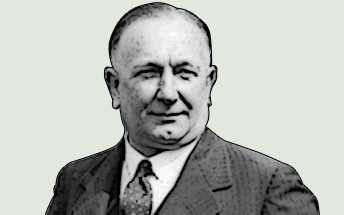
In the earliest days of football there were no specific formations or designated positions. Football was played like a children’s game of kick and run: the ball was kicked long and all the players ran towards it.
In 1863, the offside rule in football was formalized with the creation of the English Football Association. The rule stated that any player in front of the kicker is offside and cannot play the ball. The kick and run game was no more and became a game of charge-and-dribble: players dribbled the ball as far as they can towards the opponents goal with several teammates to their sides. Players rarely passed the ball and there was no real formation.
Because of excess of dribbling and the poor number of goals scored, the FA amended the offside rule. Forward passes were allowed again as long as there were three players between the receiver and the goal line. With the new rule, teams began to play a more organized football which led to the creation of tactical formations.
Below are the most influential formations in the formative years of football.
The earliest football formations: 1-2-7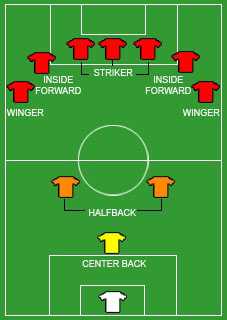
1-2-7 is the most popular formation in the 1860-70s. With only one center back, two halfbacks, and seven forwards, it reflects the all-attacking nature of football in that era. The strategy at that time was mostly based on long ball to the upfield and charge-dribbling.
The English team played with a 1-2-7 formation when they faced Scotland in 1872. The Scots, represented by Queen’s Park Rangers, utilized a 2-2-6 formation.
Unlike the English, who played a game based on individual skills, the Scots relied on short passing and teamwork. By passing the ball among each other, the Scots were able to grind an unexpected 0-0 draw against highly favored England.
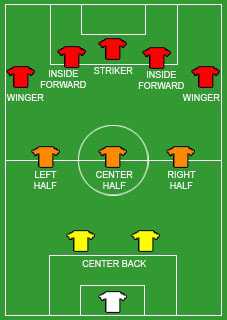 1880 – 1925: The Pyramid (2-3-5 formation)
1880 – 1925: The Pyramid (2-3-5 formation)
The 2-3-5 formation is popularly known as the “pyramid” because of its triangular shape on the blackboard. It was popularized by English football team Preston North End, which had many Scottish players on its lineup. (The arrival of Scots in English clubs in the 1880s led to the dominance of the passing strategy over the dribble and long ball type of play.)
The pyramid can be considered the first formation that relied on teamwork rather than individual effort. In defense, the left and right halves mark the opposition wingers and the center backs mark the inside forwards. The key player is the center half, who marks the opposition striker and is in charge of pivoting the team from defense to offense. After retrieving the ball in defense, he organizes his team’s attack and feeds the ball to the forwards.
Preston North End used the 2-3-5 formation to become the first winners of the English Double: winning both the English League and the FA Cup in 1889. They went through the entire season without conceding a loss, earning them the nickname “The Invincibles” and encouraging other clubs to adopt the pyramid. The formation continued to dominate English football until 1925, when the offside rules were changed to allow players to receive forward passes if there are at least two defenders between him and the goal line.
In the 1930s, a modified 2-3-5 formation was popular in Austria, Hungary, and Czechoslovakia. Called the Danubian school, its primary strategy is to distribute the ball through short ground passes. It reached its peak when Austria finished fourth in the 1934 World Cup (Football world cup 1934).
1925 – 1945: W-M formation (3-2-2-3)
The 3-2-2-3 formation was popularized by Arsenal manager Herbert Chapman in 1925 when the offside rule was changed. Chapman countered the increased pressure on defense by putting an equal number of players on the offensive and defensive ends.
Three defenders (two fullbacks, one center back) and two halfbacks make up the defensive end while two inside forwards, two wingers, and one striker make up the offense. This 3-2-2-3 formation was more popularly called as the W-M formation because the defenders’ arrangement on the field forms a “W” while the forwards form an “M.”
In a game, the W-M formation works with three forwards in front of the opponents’ goal, three defenders in front of the team’s own goal, and four players forming a square in the middle. Teams that have high-endurance midfielders can play this position with seven forwards or seven defenders at a time. This can be done by halfbacks moving up in offense and inside forwards dropping back in defense.
Arsenal is the most famous team associated with W-M. Using this formation, the club won five First Division titles and two FA Cups between 1931 and 1939. Such achievement from a previously unsuccessful club spread the use of W-M formation in all of England.
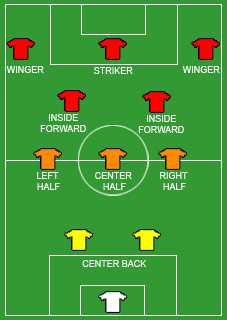 1934 & 1938: Il Metodo (2-3-2-3)
1934 & 1938: Il Metodo (2-3-2-3)
“Il Metodo” (the method) was a football formation developed by Italian manager Vittorio Pozzo in the 1930s. Fundamentally, it is a defensive adaptation of the 2-3-5 formation, formed by withdrawing two forwards from the frontline.
Two center backs protect the shoulders of the goalkeeper while the left and right halves take up the opposition wingers. The center half marks the opposing striker while two inside forwards lie deep to help on defense. The center half, just like in the pyramid position, serves as the transition from defense to offense. The offensive strategy is based on counterattacking and long balls, which the center half initiates with the inside forwards.
The Italian football team brought il metodo to prominence by winning the 1934 and 1938 World Cup titles.
1950s: M-U formation (3-2-3-2)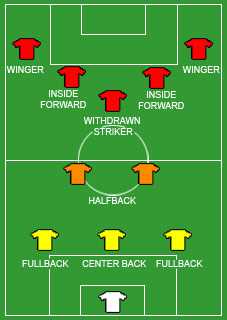
MU is a flexible football formation that was derived from the WM formation. It places equal number of players on both halves of the field and was popularized by the Hungarians in the 1950s.
The formation works with three defenders, two halfbacks, three forwards (two inside forwards & one withdrawn striker), and two wingers. The key player is the deep-lying striker, who draws out the opposing center back to make room for the other forwards. In defense, MU works the same way as the WM formation.
It can be considered that MU brought the death of the then-famous WM formation, when Hungary defeated England by a score of 6-3 in 1953. Hungarian forwards constantly swapped places, which confused a man-marking English defense and ultimately led to the blow out. The game was played in Wembley Stadium and was the English’ first defeat at the venue.
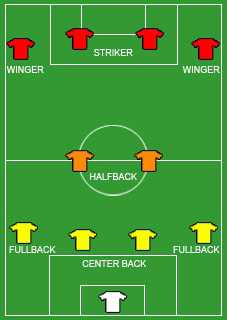 Late 1950s: 4-2-4
Late 1950s: 4-2-4
4-2-4 is the predecessor of modern football formations and was developed by the Hungarians and Brazilians independently in the late 1950s. It is the first formation that featured a four-man backline.
In defense, this formation can become a 4-3-3, with one forward dropping back to defend in midfield. The two halfbacks are tasked to block off counterattacks. Because of a weak middle, much of the defending will be left to the back four. The defenders should look to passing the ball as quick as possible to the forwards to exploit their numeric advantage.
When attacking, the formation works as 3-3-4, with one defender going up to push the ball. The two strikers give depth to the attack while the two wingers give width.
Brazil brought 4-2-4 to prominence by winning the 1958 World Cup. Since then, it has evolved to different four-back formations like 4-3-3 and 4-4-2.
